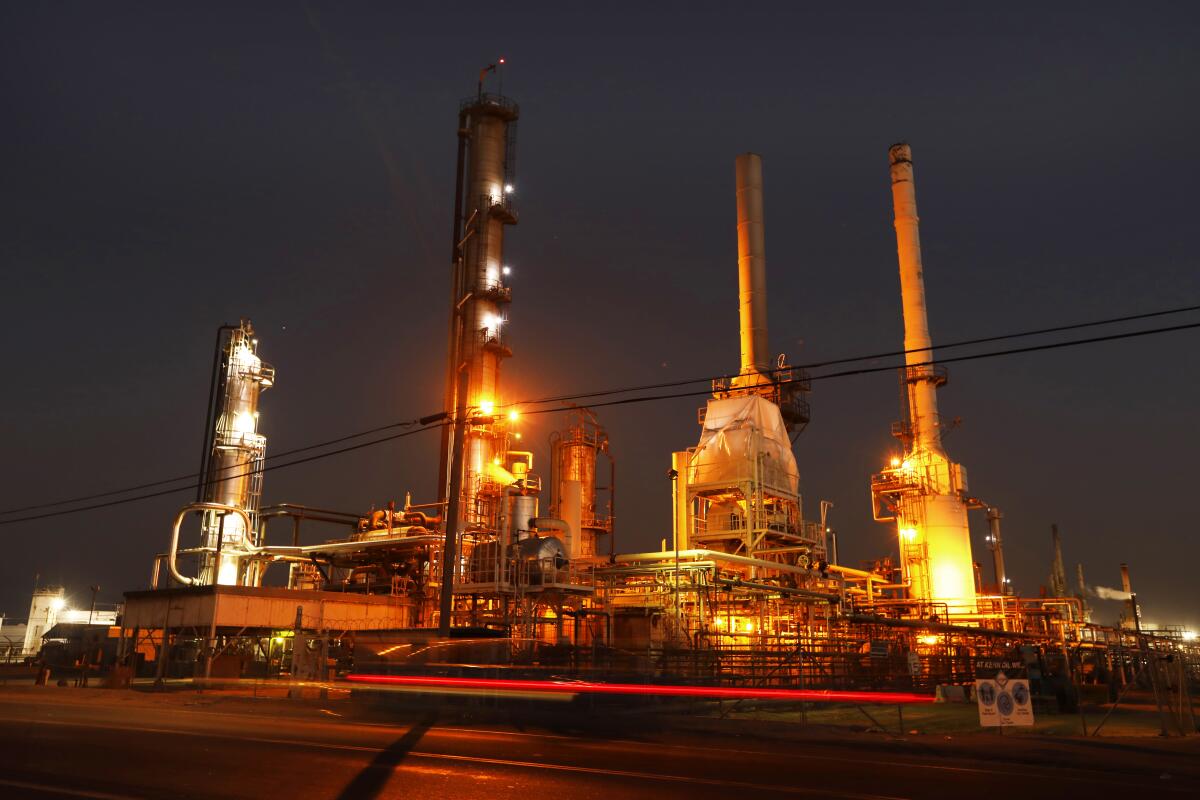Op-Ed: We can’t afford to shutter California’s aging oil refineries yet

After a summer with some historic gasoline price increases, California continues to experience the highest gas prices in the country by a considerable margin.
California’s prices are partly the result of geographic accident, with the West Coast distant from oil production and refining facilities in other states.
Officials should be careful as they wean the state off fossil fuels, a resource that will remain crucial to the state’s economy for the foreseeable future. But there may be ways to protect consumers from wild jumps in the price of gasoline, diesel, and other petroleum products.
California has long discouraged local fossil fuel production to protect the environment, with processing now increasingly reliant on an array of aging refineries. A statewide shift to electric vehicles will eventually alleviate the pressure of $6 gasoline, but California still has to meet short-term needs while maintaining its course away from fossil fuels.
In the early 20th century, California became a “petro-state” with oil output second only to Texas. By the 1960s, the California coast was dotted with oil derricks. As onshore activity slowed, companies like Union Oil and Chevron set their sights offshore. Despite considerable local opposition, by 1969 offshore drilling had commenced and 72 leases were offered to companies hoping to tap reserves off the coast.
On Jan. 28, 1969, an explosion at a Union Oil rig sent at least 80,000 barrels of crude oil into the waters less than six miles from the Santa Barbara coast, killing fish and wildlife. The disaster helped form the modern environmental movement and ended new efforts to tap California’s oil reserves. Pressure from the environmental movement forced lawmakers to place a moratorium on further drilling on offshore state land. Since 1984, there’s also been a federal moratorium on drilling on the outer continental shelf farther out to sea.
As a result, the state is largely dependent on imported crude oil, which now accounts for around 56% of the crude supplying the state’s 14 oil refineries. While the price of crude depends on global factors, the price of gasoline depends heavily on conditions in local refineries.
These facilities’ infrastructure is aging — several refineries have been operating for more than a century — and production is interrupted when machinery fails. In April, when state refineries shut down for seasonal maintenance, gasoline imports to California rose to near-record levels, sending prices soaring. Shutdowns in October again sent prices shooting upward. The locations of refineries and a lack of storage capacity also encourage refiners to export their products when market demand is low. Despite high prices, California still exports roughly as much gasoline as it imports.
The state’s commitment to cleaner energy, combined with a high gasoline tax, raises prices too. California mandates its refineries produce low-carbon fuel, and oil companies complain such measures make refinery operations more expensive.
California should celebrate the progress that its policies have encouraged. Gov. Gavin Newsom has banned all gasoline-powered vehicles by 2035, as the state embraces electric vehicles, which already account for 15% of the California auto market.
But the governor has also acknowledged the state’s need for stable gasoline supplies. In the wake of recent price spikes, Newsom permitted refiners to switch to winter gasoline blends, which are cheaper to produce. Advocacy groups are pushing to shut down California’s oil refineries, arguing the old facilities are no longer necessary. This would be premature, however. California needs gasoline, jet fuel, diesel and other refined products, and will still need them in large quantities even in 2035, when electric vehicles become the norm. California demand for gas is unlikely to fall sharply for at least a few years, in line with national trends.
On track to becoming the world’s fourth-largest economy, California requires more energy, not less. To meet short-term demand, the state should consider maintaining and upgrading existing refineries. Changes to existing legislation, including the Jones Act that constricts domestic shipborne energy trade, could assist with reversing the trend of relying on foreign imports, which are more energy intensive to transport over long distances and vulnerable to disruptions such as Russia’s war in Ukraine or Saudi Arabia’s decision to cut production in October.
High gas prices punish consumers, especially those who can’t afford electric cars. Shuttering refineries will make a bad situation even worse. A middle course, one that acknowledges near-term fuel needs, could help prevent further spikes and ensure a sustainable transition to alternative energy.
Gregory Brew is a historian of oil and a postdoctoral fellow at the Jackson School of Global Affairs at Yale University.
More to Read
A cure for the common opinion
Get thought-provoking perspectives with our weekly newsletter.
You may occasionally receive promotional content from the Los Angeles Times.










